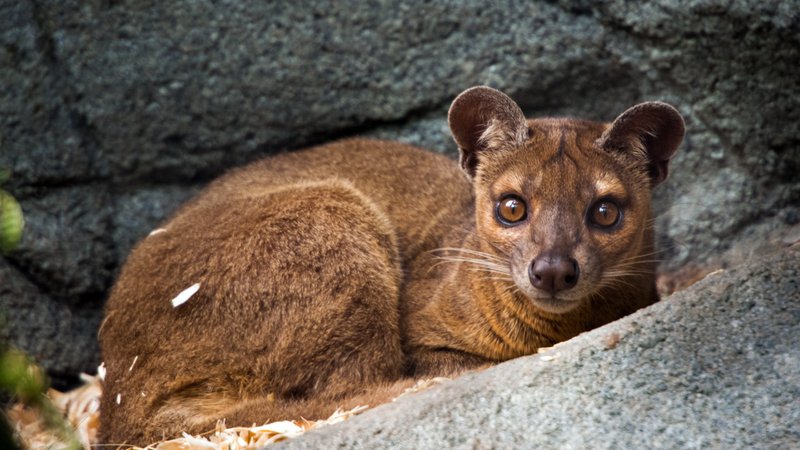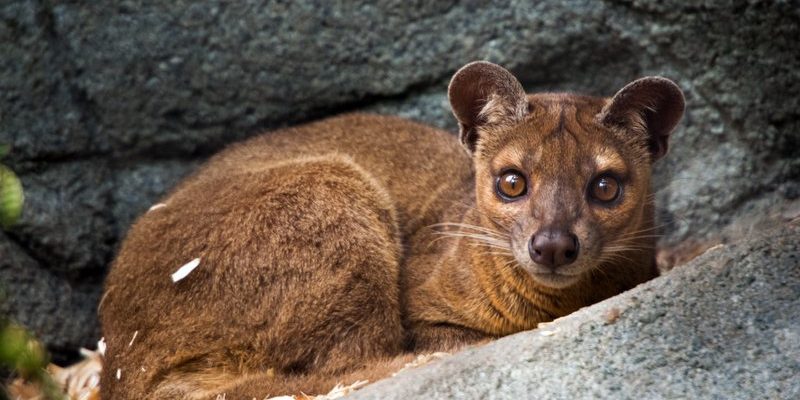
Understanding the plight of the fossa is more than just a conservation issue; it’s a matter of recognizing how interconnected our world is. The fossa plays a crucial role in maintaining the balance of its habitat, just as each instrument in a band contributes to the music we hear. In this article, we’ll explore the conservation status of the fossa, what threatens its existence, and what can be done to help save it from extinction.
What is the Fossa?
The fossa (Cryptoprocta ferox) is the largest carnivore on Madagascar, often mistaken for a feline but actually more closely related to the mongoose. These sleek, agile creatures can grow up to 6 feet long, including their long tails, which help them balance as they navigate the trees of their forest home. With their sharp claws and keen eyesight, fossas are excellent hunters, primarily preying on lemurs.
What’s fascinating is that fossas use a blend of tactics to hunt. They can leap up to 10 feet from a tree branch or run swiftly along the ground, demonstrating physical prowess that captivates anyone lucky enough to witness their agility. However, their unique adaptations are no match for the challenges they face in the wild.
The Fossa’s Endangered Status
You might be wondering, “Why is the fossa endangered?” Well, according to the International Union for Conservation of Nature (IUCN), the fossa is listed as endangered due to habitat loss, hunting, and competition with invasive species. Madagascar has experienced significant deforestation due to agriculture and logging, shrinking the fossa’s living space.
This loss of habitat not only threatens the fossa but also the biodiversity of Madagascar itself. Forests are home to many species found nowhere else on Earth, so losing them is like tearing pages out of a unique story. When fossas lose their homes, it doesn’t just affect them; it impacts an entire ecosystem.
Causes of Decline
Several factors contribute to the endangerment of the fossa. One of the primary issues is deforestation. Vast sections of Madagascar’s forests are cleared for agriculture, which directly impacts the fossa’s hunting grounds. This habitat destruction means that fossas have less territory to roam and hunt, leading to lower survival rates.
Another significant threat comes from hunting. While fossas are known to be a natural predator of lemurs, humans also hunt them for their pelts or out of fear, believing they pose a threat to livestock. Imagine a world where a vital player is misunderstood and hunted instead of protected. It’s a harsh reality for the fossa.
Invasive species also play a role. Non-native animals, such as dogs and cats, compete with fossas for food. Since the fossa is uniquely adapted to its environment, these newcomers disrupt the natural balance, making it even harder for the fossa to thrive.
Conservation Efforts in Place
Conservationists are not sitting idly by. Numerous efforts are underway to help protect the fossa and its habitat. Organizations like the Madagascar Biodiversity Partnership work tirelessly to promote sustainable land use and protect critical habitats. By educating local communities about the importance of the fossa, conservationists aim to change perceptions and reduce hunting.
Additionally, protected areas have been established to safeguard the fossa’s natural environments. National parks like Andohahela and Andasibe-Mantadia serve as safe havens where fossas can live and breed without the pressure of human interference. These parks are essential for maintaining healthy populations of both fossas and their prey.
You may have heard about ecological tourism; it’s another tool in the conservation toolbox. By promoting tourism that focuses on the natural beauty of Madagascar and its unique wildlife, communities can benefit economically without harming the environment. It’s a win-win situation where both people and wildlife can thrive.
How You Can Help
Now, you might be asking, “What can I do to help the fossa?” There are various ways you can make a difference, even from far away. Here are a few actions you can consider:
- Support Conservation Organizations: Donating to groups working in Madagascar can help provide the resources needed for conservation.
- Spread Awareness: Sharing knowledge about the fossa and its endangered status can inspire others to take action.
- Consider Eco-Tourism: If you’re planning to visit Madagascar, choose eco-friendly tour operators that promote wildlife conservation.
- Reduce Deforestation: Support products that come from sustainable sources, and advocate for policies that protect forests.
Every little bit helps, and collective action can lead to significant changes for the fossa.
The Role of Education in Conservation
Education is a cornerstone of successful conservation efforts. By teaching locals about the fossa’s role in the ecosystem, communities can learn to value and protect this unique species. We need to change the narrative surrounding the fossa so that it’s seen as a vital component of Madagascar’s natural heritage rather than a threat.
Schools and community programs focusing on wildlife conservation can inspire a new generation to appreciate and protect their environment. Imagine kids growing up with a sense of pride in their unique wildlife. That’s the kind of shift that can lead to lasting change.
Understanding whether the fossa is endangered isn’t just about knowing the facts; it’s about realizing that we all play a part in the story of conservation. The plight of the fossa reflects the broader challenges facing biodiversity across the globe. Each action we take—whether big or small—can contribute to a healthier planet.
So, let’s turn our concern into action. By raising awareness, supporting conservation efforts, and advocating for sustainable practices, we can help ensure that the fossa, and countless other species facing similar threats, continue to thrive for generations to come. After all, we wouldn’t want to lose the music of our world’s rich biodiversity, would we?

